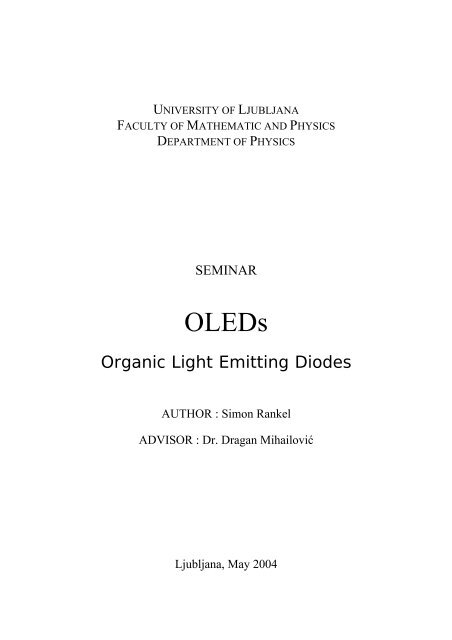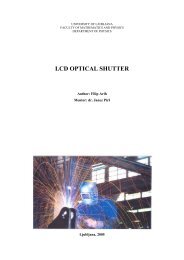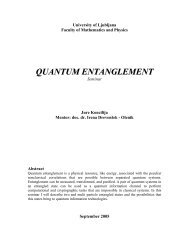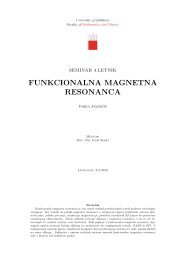You also want an ePaper? Increase the reach of your titles
YUMPU automatically turns print PDFs into web optimized ePapers that Google loves.
UNIVERSITY OF LJUBLJANA<br />
FACULTY OF MATHEMATIC AND PHYSICS<br />
DEPARTMENT OF PHYSICS<br />
SEMINAR<br />
OLEDs<br />
<strong>Organic</strong> <strong>Light</strong> <strong>Emitting</strong> <strong>Diodes</strong><br />
AUTHOR : Simon Rankel<br />
ADVISOR : Dr. Dragan Mihailović<br />
Ljubljana, May 2004
Abstract<br />
An OLED is an electronic device made by placing a series of organic thin films between two<br />
conductors. When electrical current is applied, a bright light is emitted. OLEDs are lightweight,<br />
durable, power efficient and ideal for portable applications. OLEDs have fewer process steps and also<br />
use both fewer and lower-cost materials than LCD displays. More and more people believe that<br />
OLEDs can replace the current technology in many applications.<br />
First part of this seminar is a physical overview of semiconducting properties of organic polymers<br />
and takes a deeper insight in their electron structure. Second part of seminar deals with structural<br />
OLED properties and phosphorescence material doping phenomena as improvement of efficiency.<br />
Then it offers some technical facts, the question of stability of OLEDs and so present and future<br />
aspects of use in actual products.<br />
Contents<br />
1 Introduction 3<br />
2 The physics behind OLEDs 4<br />
2.1 <strong>Organic</strong> semiconductors . . . . . . . . . . . . . . . . . . . . . . 4<br />
2.2 SSH model of electronic structure . . . . . . . . . . . . . . . . . 5<br />
2.3 Doping, charge transport . . . . . . . . . . . . . . . . . . . . . . 7<br />
2.4 <strong>Light</strong> emission . . . . . . . . . . . . . . . . . . . . . . . . . . . . 9<br />
3 OLED device structure 10<br />
3.1 Basic PLED - Charge injection . . . . . . . . . . . . . . . . . . . 10<br />
3.2 Basic SMOLED. . . . . . . . . . . . . . . . . . . . . . . . . . . 11<br />
3.3 Phosphorescent doping (Singlet, triplet excitons) . . . . . . . . . 12<br />
4 Technical facts, Stability 13<br />
5 Matrix types of OLEDs, Products 14<br />
6 Conclusion 16<br />
7 References 17<br />
2
1 Introduction<br />
The basic idea of organic LED (OLED) operation is fairly simple and similar to that of inorganic<br />
LED's. Electrons and holes are injected into an "active" region. There, they recombine resulting in<br />
photon emission. Electrons are injected in the conduction band of the appropriate organic material and<br />
holes are injected into the valence band. These carriers then move by diffusion until they meet and<br />
recombine to form excitons. When these excitons decay to their ground state, photon emission occurs.<br />
This is the same process as in fluorescence, but here caused by induced electricity and thus called<br />
electroluminiscence.<br />
In the 1960s the first LEDs on the basis of semi-conducting metals were developed and rapidly<br />
found their way to applications. At the same time, the phenomenon of electroluminescence was also<br />
observed for organic materials (anthracene single crystals).<br />
But it was not until 1987 the research group at Eastman Kodak Research Laboratories reported an<br />
organic electroluminescent diode with some remarkable characteristics [1]. By choosing organic<br />
instead of inorganic semiconductors in a novel device resembling a conventional p-n diode, they<br />
produced intensive electroluminescence while using a low-drive voltage. This efficiency indicated<br />
great potential for display applications, and intense research and development efforts on OLED ensued<br />
in numerous industrial laboratories, particularly in Japan. A little more than a decade later, the first<br />
OLED displays have been commercialized, and the technology is poised to challenge the dominance<br />
of liquid-crystal displays (LCDs) in many applications.<br />
OLEDs do not have to be manufactured in semiconductor factories (like LEDs). Nor are they<br />
limited to relatively small sizes. <strong>Organic</strong> LEDs can potentially be made with a low-cost printing line,<br />
much like you print a newspaper, so very high resolution of displays which consume little power is<br />
achievable.<br />
OLED devices can be divided into two classes: depending on the type of organic layer [8]:<br />
• Small molecule devices (SMOLED)<br />
• <strong>Organic</strong> polymer devices (PLED or LEP).<br />
Small-molecule devices are fabricated using vacuum evaporation techniques, whereas polymer<br />
structures can be applied using spin-casting or even ink-jet printing techniques. Originating at Eastman<br />
Kodak Co. (Rochester, NY), the small-molecule technology has achieved commercialization first.<br />
There has been a big advance recently also on PLEDs first discovered by researchers at Cambridge<br />
University in 1989. OLEDs based on “small molecules” have tris (8-hydroxyquinolinato) aluminum<br />
(Alq3) as the prototype (Figure 1), and only a few derivatives have been proposed so far.<br />
<strong>Organic</strong> materials used for two different types of OLED :<br />
Figure 1 : SMOLED prototype – Alq3 PLED prototype - PPV<br />
OLEDs based on polymers have poly-paraphenylene-vinylene (PPV) as the prototype (Figure 1),<br />
but over the years a number of derivatives of PPV or other polymers have been proposed and used.<br />
3
2 The physics behind OLEDs<br />
2.1 <strong>Organic</strong> semiconductors<br />
SMOLEDs are constructionally more similar to LEDs than PLEDs are, thus we first take a look at<br />
conductivity properties of polymer materials used in PLEDs. The question arrising is: How polymer<br />
becomes conductive? How can plastic conduct electricity?<br />
Polymers are made of long chain molecules entangled between each other. The polymer chains are<br />
formed by connecting many small molecular units called monomers (Fig. 2)[9].<br />
Figure 2: polymer chain building<br />
Most polymers are organic compounds, which means they are composed mostly of carbon chains with<br />
hydrogen, oxygen and nitrogen atoms. These atoms form covalent bonds where the electrons are<br />
localized in the low energy bonding orbitals of the chain molecule. Hence polymers typically do not<br />
conduct electricity and are used in electronic application as insulator.<br />
The prototypical conducting polymer is polyacetylene (PA), (CH)n (Fig. 3). Every bond contains a<br />
localized “sigma” (σ) bond which forms a strong chemical bond. In addition, every double bond also<br />
contains a less strongly localised “pi” (π) bond which is weaker. A π molecular orbital is thus formed<br />
when two carbon atoms form a double bond and the 2pz orbitals have the same symmetry. The<br />
electrons in this π orbital have equal probability of being around each carbon nucleus.<br />
Figure 3: 2pz orbitals interact and form a “conductive” electron cloud<br />
Morover, π-bonding, in which the carbon orbitals are in the sp²pz configuration and in which the<br />
orbitals of successive carbon atoms along the backbone overlap, leads to electron delocalization along<br />
the backbone of the polymer. (Delocalized electrons are electrons that are shared by more than two<br />
atoms). This electronic delocalization provides the “highway” for charge mobility along the backbone<br />
of the polymer chain. [2]<br />
As a result, therefore, the electronic structure in conducting polymers is determined by the chain<br />
symmetry (i.e. the number and kind of atoms within the repeat unit), with the result that such polymers<br />
can exhibit semiconducting or even metallic properties.<br />
Actually because of the Peierls Instability with two carbon atoms in the repeat unit, the π-band is<br />
divided into π- and π* bands (Fig. 4) [10]. What Peierls showed is that due to the coupling between<br />
electronic and elastic properties the polymer develops a structural distortion such as to open a gap in<br />
the electronic excitation spectrum.<br />
4
Figure 4: Bonding and anti-bonding (*) π orbitals<br />
Since each band can hold two electrons per atom (spin up and spin down), the π-band is filled and the<br />
π*-band is empty. The energy difference between the highest occupied state in the π-band and the<br />
lowest unoccupied state in the π*-band is the π-π* energy gap, Eg. The bonding orbital (π) corresponds<br />
to the valence “band” of the semiconductor and the antibonding orbital (π*) corresponds to the<br />
conduction “band”. Each conjugated part of a molecule in a conjugated material is characterized by a<br />
band-like energy distribution in the electronic density of states with an energy gap between the<br />
Highest Occupied Molecular Orbital (HOMO) and the Lowest Unoccupied Molecular Orbital<br />
(LUMO). This energy band structure is similar to a semiconductor. In this form polymer is a poor<br />
electrical conductor. In a diatomic molecule, a molecular orbital (MO) diagram can be drawn showing<br />
a single HOMO and LUMO, corresponding to a low energy π orbital and a high energy π* orbital.<br />
Figure 5: molecular orbital diagram<br />
Every time an atom is added to the molecule, a further MO is added to the MO diagram (Fig. 5).<br />
Thus for a PPV chain which consists of ~1300 atoms involved in conjugation, the LUMOs and<br />
HOMOs will be so numerous as to be effectively continuous. And this results in two bands we<br />
mentioned above. They are separated by a band gap which is typically 0-10eV and depends on the<br />
type of material. PPV has a band gap of 2.5eV.<br />
2.2 SSH model of electronic structure<br />
The Su-Schrieffer-Heeger (SSH) model is a simple tight-binding model for polyacetylene [11]. In<br />
this model, the coordinates and motion of the atomic nuclei is treated classically, but the π -electron<br />
dynamics is treated fully quantummechanically in a tight-binding approximation. The crucial aspect of<br />
the model is that the coupling between the nuclear coordinates is taken into account via the distancedependent<br />
hopping terms. The idea behind this is simply that the overlap integrals between<br />
neighboring atomic orbitals increase when the distance between neighboring atoms decreases.<br />
Conjugated polymers are π-bonded macromolecules in which the fundamental monomer unit is<br />
repeated many times. Thus, N, the Staudinger index as in (CH)N, is large. Since the end-points are not<br />
important when N is large, the π-electron transfer integral t tends to delocalize the electronic<br />
wavefunction over the entire macromolecular chain. This tendency toward delocalization is limited by<br />
5
disorder (which tends to localize the wavefunctions) and by the Coulomb interaction, which binds<br />
electrons when transferred to a nearby repeat unit to the positive charge left behind (a hole).<br />
The construction of the remarkably successful SSH Hamiltonian is based on two assumptions [2]:<br />
(a) The π-electronic structure can be treated in the tight-bonding approximation with a transfer integral<br />
t ≈ 2.5 eV, and (b) The chain of carbon atoms is coupled to the local electron density through the<br />
length of the chemical bonds.<br />
tn, n+<br />
1 = to<br />
+ α ( un<br />
+ 1 − un<br />
)<br />
(1)<br />
where tn , n+<br />
1 is the bond-length dependent hopping integral from site n to n +1 and n is the<br />
displacement from equilibrium of the carbon atom. The first assumption defines the lowest order<br />
hopping integral, , in the tight-binding term that forms the basis of the Hamiltonian (Eqn. 2). The<br />
second assumption provides the first-order correction to the hopping integral. This term couples the<br />
electronic states to the molecular geometry, giving the electron-phonon (el-ph) interaction where α is<br />
the el-ph coupling constant. The precise form of Eqn. (1), in which the dependence of the hopping<br />
integral on the C-C distance is linearized for small deviations about , is the first term in a Taylor<br />
expansion.The resulting SSH Hamiltonian is then written as the sum of three terms:<br />
u<br />
th<br />
n<br />
to<br />
to<br />
H<br />
∑<br />
2<br />
+<br />
+<br />
pn<br />
1<br />
2<br />
[ −to<br />
+ α ( un+<br />
1 − un<br />
)]( cn+<br />
1,<br />
σ cn,<br />
σ + cn,<br />
σ cn+<br />
1.<br />
σ ) + ∑ + K∑(<br />
un<br />
1 − un<br />
) (2)<br />
2m<br />
2<br />
SSH = +<br />
n,<br />
σ<br />
n n<br />
where pn are the nuclear momenta, n are the displacements from equilibrium, m is the carbon mass,<br />
and K is an effective spring constant. The and are the fermion creation and annihilation<br />
operators for site n and spin σ. The last two term are, respectively, a harmonic »spring constant« term<br />
which represents the increase in potential energy that results from displacement from the uniform<br />
bonds lenghts in (CH)x and a kinetic energy term for the nuclear motion.<br />
u<br />
+<br />
cn, σ cn,<br />
σ<br />
Figure 6: Electronic structure of semiconducting PA; left - Band structure, right - Density of<br />
states. The energy opens at k = π/2a as a result of Peierls distortion<br />
The spontaneous symmetry breaking due to the Peierls instability implies that for the ground state<br />
of a pristine chain, the total energy is minimized for u n > 0 .Thus to describe the bond alternation in<br />
the ground state, we use:<br />
u )<br />
n<br />
n → un<br />
= (−1<br />
uo<br />
(3)<br />
With this mean-field approximation, the value uo<br />
which minimizes the energy of the system can be<br />
calculated as a function of the other parameters in the Hamiltonian. Qualitatively, however, one sees<br />
6
that uo and - o both minimize the energy for trans-polyacetylene since the bonds all make the same<br />
angle with respect to the chain axis. Hence, the energy as a function of u has a double minimum at<br />
± , as shown in Fig. 7 [2,12].<br />
u<br />
u<br />
o<br />
Figure 7: Total energy of the dimerized polyacetylene chain<br />
Strictly speaking, the SSH model is directly applicable only to polyacetylene; however, recent<br />
work has shown that the primary excitation in luminescent polymers like PPV can also be described<br />
within the linear chain model. In PPV and its derivatives, the lowest excitonic wave function extends<br />
over several repeat units; the properties of excitons are therefore not very sensitive to the delicate<br />
structure within the unit.<br />
2.3 Doping, charge transport<br />
In conjugation, the bonds between the carbon atoms are alternately single and double. However,<br />
conjugation is not enough to make the polymer material conductive. In addition – and this is what the<br />
dopant does – charge carriers in the form of extra electrons or holes have to be injected into the<br />
material. Before a current can flow along the molecule one or more electrons have to be removed or<br />
inserted. If an electrical field is then applied, the electrons constituting the π bonds can move rapidly<br />
along the molecule chain. The conductivity of the plastic material, which consists of many polymer<br />
chains, will be limited by the fact that the electrons have to "jump" (hop) from one molecule to the<br />
next. Hence, the chains have to be well packed in ordered rows.<br />
There are two types of doping, oxidation or reduction. In the case of PA the reactions are written:<br />
Oxidation with halogen (p-doping): [CH]n + 3x/2 I2 → [CH]n x+ + x I3 -<br />
Reduction with alkali metal (n-doping): [CH] n + x Na → [CH]n x- + x Na +<br />
However, it is not the iodide or sodium ions that move to create the current, but the electrons from the<br />
conjugated double bonds.<br />
The mechanisms of conductivity in doped polymers are based on the motion of charged defects<br />
within the conjugated framework. In solid state physics these charged excitations are usually described<br />
as positive or negative solitons (ion defects) and polarons (radical ion defects) respectively [13].<br />
The trans-structure of polyacetylene possesses a two-fold degenerate ground state (Fig. 8) and<br />
single and double bonds can be interchanged without changing energy. A break in pattern of bond<br />
alternation separates degenerate ground-state structures.<br />
Figure 8: degenerate phases in trans-polyacetylene<br />
7
This break leads to a free radical defect, a so-called neutral soliton which is relatively stable<br />
(Figure 9). Addition of an acceptor removes an electron and creates a positive soliton (or a neutral one<br />
if the electron removed is not the free electron). The resulting carbocation is stabilised by having the<br />
charge spread over several monomer units and the charged solitons are responsible for making<br />
polyacetylene a conductor<br />
Figure 9: Charge defects in polyacetylene and oxidative doping.<br />
A further type of charge storage occurs when the generated charge and the radical are coupled to<br />
each other via local resonance of the charge and the radical. This type of charge transport is present in<br />
polymers like PPV. This combination of a charge site and a radical dependent of each other is called a<br />
polaron. A new localised electronic state is created in the band gap, with the lower energy states being<br />
occupied by a single unpaired electron. Unlike the soliton, the polaron cannot move without first<br />
overcoming an energy barrier so movement is by a hopping motion.<br />
FIGURE 10: Radical cation (”polaron”) formed by removal of one electron on the 5th carbon<br />
atom of a undecahexaene chain (a ―> b). The polaron migration shown in c ―> e.<br />
If a second electron is removed from an already oxidised section of the polymer, either a second<br />
independent polaron may be created or, if it is the unpaired electron of the first polaron that is<br />
removed, a bipolaron is formed (with lower energy than 2 polarons) (Figure 11). The two positive<br />
charges of the bipolaron are not independent, but move as a pair, like the Cooper pair in the theory of<br />
superconductivity. While a polaron, being a radical cation, has a spin of 1/2, the spins of the<br />
bipolarons sum to S = 0.<br />
8
Figure 11: Band theory model in polymers. At high doping level, the soliton regions tend to<br />
overlap and create new mid-gap energy bands that may merge with the valence and conduction<br />
bands allowing freedom for extensive electron flow. However, for most heavily doped conjugated<br />
polymers it is conceivable that the upper and the lower bipolaron bands will merge with the<br />
conduction and the valence bands respectively to produce partially filled bands and metallic like<br />
conductivity. Conduction occurs because the mean free path of a charge carrier extends over a<br />
large number of lattice sites. The residence time on each site is small compared with the time it<br />
would take for a carrier to become localized.<br />
The mechanisms of charge transport in polymers are still not fully elucidated. One example is that a<br />
stretched polyacetylene shows a better conductivity than the same material without orientated<br />
morphology and it remains under investigation how inter-chain charge transfer takes place.<br />
2.4 <strong>Light</strong> emission<br />
Conjugated polymers can show photoluminescence as well as electroluminescence. The first being<br />
obvious from the fluorescent colour a typical light emitting polymer like PPV exhibits. This is due to<br />
the relaxation of a singlet excited state generated [13] by the absorption of a photon (Figure 12). A<br />
similar process is responsible for the electroluminescence of a conjugated polymer but the generation<br />
of the excited state is different. Instead of excitation by a photon, a negative electrode injects electrons<br />
(generation of radical anions) and a positive electrode injects holes (generation of radical cations)<br />
respectively. Electrons and holes can combine as they are attracted to each other by Coulomb<br />
interactions. This leads to the formation of neutral bound excited states termed excitons. The spin<br />
wavefunction of an exciton can be triplet or singlet as in the case of photoluminescence. The<br />
decomposition of them leads to light emission. The emitted wavelength of an electrically excited<br />
conjugated polymer depends crucially on its band gap<br />
c<br />
Eg = h<br />
(4)<br />
λ<br />
where h is Planck’s constant and c is the speed of light. PPV produces yellow-green luminescence (Eg<br />
= 2.5 eV).<br />
9
Figure 12: Photoluminiscence and electroluminiscence in conjugated polymers. a) Irradiation can<br />
excite an electron from the LUMO in the HOMO and two new energy states are generated. Both<br />
are filled with an electron of opposite spin (singlet exited state). Relaxation to the ground state<br />
leads to the emission of light of smaller frequency. b) In order to show electroluminescence,<br />
radical ions have to be produced in the polymer by the application of an electric field. When<br />
radical ions of opposite charge combine, so-called excitons (singlet or triplet excited state) are<br />
formed and the decomposition of this neutral excited state (recombination) leads to radiative<br />
emission.<br />
3 OLED device structure<br />
An OLED device consists of one or more semiconducting organic thin films sandwiched between two<br />
electrodes – one of which must be transparent. (Fig. 13).<br />
3.1 Basic PLED<br />
Figure 13: basic (two-layer) OLED structure<br />
The energy level diagram of a typical single layer PLED is shown in Figure 14. The device utilizes<br />
~100 nm of PPV with an ITO anode and calcium cathode [3,14].<br />
Figure 14: PLED device operation (energy diagram)<br />
10
When a forward bias is applied, electrons are injected from the cathode into the LUMO of the<br />
polymer and holes are injected from the anode into the HOMO of the polymer. Thus, the electrons<br />
must overcome the barrier (electron injection barrier) between the Ca Fermi level and the LUMO level<br />
of the polymer. Low work function metals such as Mg or Ca are typically used to minimize this barrier<br />
and provide an ohmic contact. A good energy match between cathode and LUMO means that not<br />
much energy is lost when electrons are injected. Similarly, to ensure ohmic injection of holes from the<br />
ITO Fermi level into the HOMO of the polymer, the ITO may be treated in various ways (e.g.,<br />
exposure to an ultraviolet-ozone cleaning) to lower its Fermi level. (barrier is here called hole injection<br />
barrier.)<br />
3.2 Basic SMOLED<br />
The p-n diode structure proves to be a key feature for the OLED device. The basic structure of<br />
SMOLED consists of two layers of organic thin films - a hole transport layer – HTL (p-layer by LED)<br />
and an electron transport layer - ETL (n-layer by LED) - sandwiched between an anode and a cathode<br />
(Fig. 15). These two organic layers, each on the order of about 500 Å thick, provide the appropriate<br />
media for transporting charge carriers, toward the interface formed between the two layers [15].<br />
Figure 15: A basic OLED device structure consists of a hole-transport layer and an electron<br />
transport layer sandwiched by a cathode and anode.<br />
One of the most basic SMOLED device structures uses an organic material called NPB (naphthyl<br />
substituted benzidine derivative) as HTL and Alq3 as ETL. In this typical structure we use indium tin<br />
oxide (ITO) as the transparent anode and magnesium-doped silver (Mg:Ag) as the cathode.<br />
When voltage is applied, charge injection of electrons through the cathode and hole through the<br />
anode occurs. Electrons are transported to the LUMO of the ETL, and holes to the HOMO of the HTL.<br />
Recombination of these charges occurs across the barriers, with holes primarily moving into alq3 (Fig.<br />
16). Excitons formed in Alq3 in this case emit green fluorescence. See Flash movie [16].<br />
Figure 16: SMOLED device operation (energy diagram)<br />
11
This two-layer design also is important because it provides the necessary energetic barriers at the<br />
interface to effectively localize the recombination of the oppositely charged carriers at or near the<br />
interface region. As a result, this organic interface region, on the order of 100 to 200 Å thick, is also<br />
primarily responsible for the light generation from the SMOLED device.<br />
3.3 Phosphorescent dopping (Singlet, Triplet excitons)<br />
The process of charge injection and recombination in OLEDs results in the generation of singlets and<br />
triplets. Quantum statistics limits the direct generation of singlets to 25%, while the rest of the<br />
excitons, 75 % are triplets (Figure 17). In traditional OLEDs, which are fluoroscence based, only the<br />
singlet excitons contribute directly to the light generation process. Taking into consideration the<br />
device plannar geometry, and other factors, the external quantum efficiency is limited to about 5% [5].<br />
Significant increases in the device quantum efficiency can be brought upon by allowing the triplets to<br />
contribute to the light-emission process. This can be achieved by using phosphorescent dyes in an<br />
appropriate host material [15].<br />
Figure 17: singlet and triplet exciton light emission<br />
Even though highly fluorescent dyes increase EL efficiencies for small-molecule OLEDs, they<br />
only harness a fraction of all electrically generated excitons. Two types of excitons are formed when<br />
electrically injected carriers recombine: singlet excitons with total spin S = 0 and triplet excitons with<br />
total spin S = 1. Since the ground state of organic molecules has S = 0, and the relaxation of a<br />
molecule through the radiative recombination of an exciton must conserve spin, fluorescent emission<br />
from singlet excitons is the only allowed process that generates photons. Hence, for typical<br />
fluorescent-based OLEDs, all triplet excitons are wasted. For small-molecule devices, it is believed<br />
that only 25% of the emissive singlet excitons are formed during electrical excitation. However, some<br />
materials do exhibit light emission from triplet excitons. In these materials, the singlet and triplet<br />
states are mixed and hence the excited triplet states share some singlet character and radiative decay to<br />
the ground state is allowed. This process is known as phosphorescence. Adding a heavy metal atom<br />
such as iridium to an organic molecule increases the spin-orbit coupling that mixes singlet and triplet<br />
excited states allowing for efficient radiative decay of triplet excitons.<br />
The energy level schematic of an OLED employing an iridium-based phosphorescent small<br />
molecule is shown in Figure 18. Here, two ETL layers are used - one (CBP) hosts the phosphorescent<br />
iridium complex and one (BCP) acts solely as a hole (and exciton) blocking layer. Upon injection,<br />
holes are transported in the HTL and recombine with the electrons that have been injected into the hole<br />
blocking layer and have drifted to the CBP ETL. Both singlet and triplet excitons are formed in the<br />
CBP host and then both types of excitons are transferred nonradiatively to the emissive state of the<br />
iridium complex. This state then emits light through phosphorescence. The net effect is that both the<br />
singlet and triplet excitons created in CBP are utilized for light emission. And this clearly<br />
demonstrates the potential of high efficiency OLEDs based on phosphorescence.<br />
12
Figure 18: Schematic energy level diagram of an optimized small molecule OLED employing the<br />
phosphorescent complex: Ir(ppy)3 doped into a CBP host. HTL is a thin film of (α-NPD). A BCP<br />
molecule with a large HOMO-LUMO spacing is used here as both a carrier and exciton blocking<br />
layer. A bilayer cathode consisting of a thin (
5 Matrix types of OLEDs, Products<br />
An OLED is a current-driven device. That is, the intensity of the output light is directly<br />
proportional to the electrical current flow through the device. An OLED display, therefore, requires<br />
the control and modulation of electrical current levels through individual elements (pixels) in order to<br />
display text or graphic images.<br />
There are two types of OLED display architectures: passive matrix and active matrix. In a<br />
passive-matrix OLED display, the columns provide the data signal, and the rows are addressed one at<br />
a time. The current flow through a selected row is necessarily pulsed to a level that is proportional to<br />
the total number of rows in the display. This instantaneous current requirement places a restriction on<br />
the size and resolution of the passive matrix design. This restriction is removed in an active-matrix<br />
OLED display, where each individual pixel can be designed to switch on or off within a frame time.<br />
As a result, the device does not suffer the resolution limitations or the high-instantaneous-current<br />
requirements of a passive-matrix design. The size and resolution of these displays are determined by<br />
practical considerations such as the constraints of the substrates rather than the OLED component.<br />
Because the pixel architecture and electrode geometry for the OLED element are already defined on<br />
the substrate, the fabrication of the OLED component is straightforward. The cathode is continuous<br />
over the entire display area, requiring no patterning.<br />
In 1998 Pioneer put on the market first commercially available passive matrix OLED displays in<br />
car radio CD-players (Fig. 20).<br />
Figure 20: 2004 range of Pioneer car radios ; left - Pioneer DEH-P 6600 with blue OLED<br />
display (280$), right - Pioneer DEH-P 8600 with full color OLED display (550 $)<br />
These small molecule based displays were also found in Motorola cellular phones by 2000. Recently<br />
also mobile phones from other manufactorers came on market, with external 256 colors OLEDs as<br />
complement to bigger internal LCDs like in Samsung presented below (Figure 21). In 2003 Kodak<br />
introduced a digital camera incorporating the first commercially available active matrix OLED<br />
display. After Motorola<br />
Figure 21: a) Samsung SGH-E 700 b) Kodak EasyShare LS633 (120.000 SIT)<br />
14
Nearby Future<br />
a) Big screens - The technology will provide competitive full-size computer displays and flat-panel<br />
TV screens that consume less power than possible with flat panel technologies available today.<br />
A prototype of world's largest (till now) - 20"<br />
OLED full color display, WXGA (1280x768)<br />
with Low power consumption driven by<br />
Amorphous Silicon TFTs has been presented in<br />
2003 (Figure 22) by Chi Mei Optoelectronics<br />
Corporation (CMO) from Taiwan.<br />
Figure 22: Technical details: The 20-inch prototype is a top-emitting full-color active-matrix<br />
display. It has WXGA resolution (1280 x 768 pixels) and a power consumption of 25 Watt at a<br />
brightness of 300 cd / m² (its desktop display brightness, can exceed 500 cd/m2) [19].<br />
b) FOLEDs - flexible OLEDs [7] are organic light emitting devices built on flexible substrates (Fig.<br />
23). Flat panel displays have traditionally been fabricated on glass substrates because of structural<br />
and/or processing constraints. Flexible materials have significant performance advantages over<br />
traditional glass substrates.<br />
For the first time, FOLEDs may be made on a wide<br />
variety of substrates that range from optically-clear<br />
plastic films to reflective metal foils. These materials<br />
provide the ability to conform, bend or roll a display into<br />
any shape. This means that a FOLED display may be<br />
laminated onto a helmet face shield, a military uniform<br />
shirtsleeve, an aircraft cockpit instrument panel or an<br />
automotive windshield [20].<br />
Figure 23: FOLED for DARPA, courtesy Universal Display<br />
FOLEDs will also generally be less breakable, more impact resistant and more durable compared to<br />
their glass-based counterpart [7].<br />
c) <strong>Light</strong>ning applications - The rapid progress in efficiency and performance demonstrated by OLED<br />
technology over the last decade has caused many companies to consider OLEDs as a potential solidstate<br />
light source for lighting applications. In terms of application potential, OLEDs nicely<br />
complement inorganic LEDs - a technology more often associated with solid-state lighting (SSL). In<br />
particular, since inorganic LEDs are bright point sources of light, they are naturally suited for<br />
applications such as spot or task lighting that require spatial control over the illuminating beam. In<br />
contrast, OLEDs represent a diffuse source of light and so are naturally suited to large area generallighting<br />
and signage applications where, for instance, fluorescent lighting is used today.<br />
15
6 Conclusion<br />
The future prospect looks bright for OLED flat panel displays. OLED displays have been used in<br />
aftermarket car audio for the last several years. They are starting to find use in cell phones as<br />
secondary displays and are expected to enter the market this year in the form of full color displays for<br />
cell phones. Many industry analysts predict OLED displays for laptops and computer monitors will<br />
start to enter the market as soon as 2006. Other applications, such as flexible displays for outdoor<br />
advertising signage and billboards, are further out in time. This application requires over 50 times<br />
performance improvement in OLED materials in brightness and lifetime, and also requires a complex<br />
active matrix drive scheme, inkjet deposition for low cost manufacturing, and flexible substrates.<br />
Therefore, given the requirements and capabilities of billboard application, it may not be realized<br />
within the next five years. Another advanced application for OLED materials includes replacement for<br />
fluorescent room lighting, which again depends upon substantial improvement in the performance of<br />
materials, in particular, energy efficiency. Meanwhile, in the short term, OLED displays have started<br />
and will continue to penetrate the $30 billion dollar display market and have begun to realize their<br />
bright future ahead.<br />
16
7 References<br />
[1] C.W.Tang and S.A. Van Slyke, <strong>Organic</strong> electroluminiscent diodes; Appl. Phys. Lett. 51, 913<br />
(1987)<br />
[2] Alan J.Heeger, Semiconducting and Metallic Polymers: The fourth generation of polymeric<br />
materials, Nobel Lecture, December 8, 2000<br />
[3] C.W. Tang, S.A. VanSlyke and C.H. Chen, Electroluminiscence of doped organic thin films;<br />
J. Appl. Phys. 65, 3610 (1989)<br />
[4] G.Parthasarathy et al., <strong>Organic</strong> <strong>Light</strong> Emiiting Devices; The Electrochem. Soc. Int, Summer 2003<br />
[5] G.E.Jabbour et al., High-efficieny organic electrophosphorescent devices through balance of<br />
charge injection; Appl. Phys. Lett. 80, 2026 (2002)<br />
[6] Ioannidis et al., C-V characteristic of OLEDs; Appl. Phys. Lett. 72, 3038 (1998)<br />
[7] Anna. B. Chwang et al., Thin film encapuslated flexible organic electroluminiscent displays;<br />
Appl. Phys. Lett. 83, 413 (2003)<br />
Internet:<br />
[8] http://www.calpoly.edu/~drjones/chem447/Polymers%20CD/Files/LED/pledsoleds.htm<br />
[9] http://classes.engr.arizona.edu/mse110/Lab/CP.pdf<br />
[10] http://www.colby.edu/chemistry/CH145/CH145Lab/MO%20Lab%20-CH1452001.pdf<br />
[11] http://www.ilorentz.org/~saarloos/Correlateds/soundvel.html<br />
[12] http://www.nobel.se/chemistry/laureates/2000/public.html<br />
[13] http://www.chemonaut.de/dateien/CHEM364.pdf<br />
[14] http://www.electrochem.org/publications/interface/summer2003/IF6-03-Pages42-47.pdf<br />
[15] http://oemagazine.com/fromTheMagazine/feb01/brightness.html<br />
[16] http://www.optics.arizona.edu/oled/INTRO.HTM<br />
[17] http://oemagazine.com/fromTheMagazine/jun02/pdf/polymers.pdf<br />
[18] http://www.tu-darmstadt.de/fb/ms/fg/em/OLED.pdf<br />
[19] http://www.idtech.co.jp/en/news/press/20030312.html<br />
[20] http://www.universaldisplay.com/foled.php - FOLED movie<br />
other links:<br />
www.osram-os.com/<br />
http://www.erc.arizona.edu/Education/REU/Student%20Reports%2003/chris%20report.pdf<br />
http://www.research.ibm.com/journal/rd/451/curioni.html<br />
http://www.eurekalert.org/pub_releases/2003-03/giot-nta032103.php<br />
http://www.rochester.edu/college/workshop/presentations/MarkThompson/MT_2003.pdf<br />
http://www.usc.edu/org/techalliance/Anthology2003/Final_Crawford.pdf<br />
http://www.physicstoday.org/pt/vol-54/iss-12/p42.html<br />
http://www-mtl.mit.edu/MEngTP/John_Ho_Proposal.pdf<br />
17

















